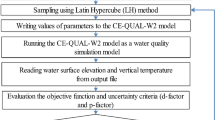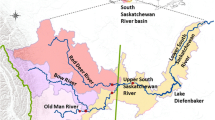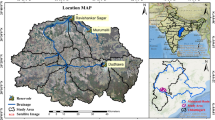Abstract
As crucial as it is to monitor the water quality in the reservoirs, constant measurement of different water quality indices can become a serious challenge. One way to alleviate this predicament is to create accurate numerical models and yet, the modeling process itself can have various problems that need to be addressed effectively. One major problem regarding water quality modeling is the high number of parameters and the uncertainty accompanying them. Eutrophication, being a significant water quality issue in the water reservoirs, is no exception and is related to a multitude of parameters. This paper presents an uncertainty-based auto-calibrated two-dimensional water quality and hydrodynamic (CE-QUAL-W2) model which was developed to simulate the eutrophication phenomenon in the Karkheh Reservoir in Iran. Automatic calibration of the CE-QUAL-W2 model using the Sequential Uncertainty Conformity Algorithm (SUFI-2) resulted in 11, 12.8, 10, 14.7, and 37.5 percent lower root mean square error (RMSE) for dissolved oxygen, total phosphorus, NH4, NO3-NO2, and Chlorophyll-a, respectively, compared to the results obtained by the particle swarm optimization (PSO). Furthermore, 76 percent of the measured data were in a 95 percent confidence interval as a result of calibration with the SUFI-2. In addition, the SUFI-2 algorithm outperformed the PSO algorithm within just 250 function evaluations, which was 20 times fewer than what was required by the PSO. Based on the results, it seems that the SUFI-2 algorithm can help the calibration process to achieve a more accurate and reliable model while decreasing the computational burden of the modeling process.








Similar content being viewed by others
Availability of data and material
Available upon reasonable request from the authors.
References
Abbaspour KC, Van Genuchten MT, Schulin R, Schläppi E (1997) A sequential uncertainty domain inverse procedure for estimating subsurface flow and transport parameters. Water Resour Res 33:1879–1892. https://doi.org/10.1029/97WR01230
Abbaspour KC, Johnson CA, van Genuchten MTh (2004) Estimating uncertain flow and transport parameters using a sequential uncertainty fitting procedure. Vadose Zone J 3:1340–1352. https://doi.org/10.2113/3.4.1340
Abbaspour KC, Yang J, Maximov I et al (2007) Modelling hydrology and water quality in the pre-alpine/alpine Thur watershed using SWAT. J Hydrol 333:413–430. https://doi.org/10.1016/j.jhydrol.2006.09.014
Afshar A, Kazemi H, Saadatpour M (2011) Particle swarm optimization for automatic calibration of large scale water quality model (CE-QUAL-W2): application to Karkheh reservoir, Iran. Water Resour Manag 25:2613–2632. https://doi.org/10.1007/s11269-011-9829-7
Afshar A, Shojaei N, Sagharjooghifarahani M (2013) Multiobjective calibration of reservoir water quality modeling using multiobjective particle swarm optimization (MOPSO). Water Resour Manage 27:1931–1947
Ambrose RB, Wool TA, Connolly JP, Schanz RW (1988) A Hydrodynamic and Water Quality Model: Model Theory, User’s Manual and Programmers Guide. WASP4, ERL: Office ofR&D, USEPA, Athens, GA, EPN600/3–87/039
Cao Y, Zhang J, Yang M et al (2018) Application of SWAT model with CMADS data to estimate hydrological elements and parameter uncertainty based on SUFI-2 algorithm in the Lijiang River basin, China. Water (Switzerland). https://doi.org/10.3390/w10060742
Cole TM, Wells SA (2006) CE-QUAL-W2: A two-dimensional, laterally averaged, hydrodynamic and water quality model, version 3.5
de Oliveira TF, de Sousa Brandão IL, Mannaerts CM et al (2020) Using hydrodynamic and water quality variables to assess eutrophication in a tropical hydroelectric reservoir. J Environ Manag. https://doi.org/10.1016/j.jenvman.2019.109932
Finley JR, Pintér JD, Satish MG (1998) Automatic model calibration applying global optimization techniques. Environ Model Assess 3:117–126. https://doi.org/10.1023/a:1019010822186
Furnas MJ (1992) The behavior of nutrients in tropical aquatic ecosystems. Pollution in tropical aquatic systems 29–65
Glibert PM, Al-Azri A, Icarus Allen J et al (2018) Key questions and recent research advances on harmful algal blooms in relation to nutrients and eutrophication. Springer, Cham, pp 229–259
Hassan AE, Bekhit HM, Chapman JB (2008) Uncertainty assessment of a stochastic groundwater flow model using GLUE analysis. J Hydrol 362:89–109. https://doi.org/10.1016/j.jhydrol.2008.08.017
Hodges B, Dallimore C (2001) Estuary and lake computer model: ELCOM science manual code version 2.0. 0. Centre for Water Research, University of Western Australia, Perth
Huo A, Huang Z, Cheng Y, van Liew MW (2020) Comparison of two different approaches for sensitivity analysis in Heihe River basin (China). Water Sci Technol Water Supply 20:319–327. https://doi.org/10.2166/ws.2019.159
Kennedy J, Eberhart R (1995) Particle swarm optimization. In: Proceedings of ICNN’95-international conference on neural networks. IEEE, pp 1942–1948
Lehbab-Boukezzi Z, Boukezzi L, Errih M (2016) Uncertainty analysis of HEC-HMS model using the GLUE method for flash flood forecasting of Mekerra watershed. Algeria Arab J Geosci 9:751. https://doi.org/10.1007/s12517-016-2771-5
Masoumi F, Najjar-Ghabel S, Safarzadeh A, Sadaghat B (2020) Automatic calibration of the groundwater simulation model with high parameter dimensionality using sequential uncertainty fitting approach. Water Supply 20:3487–3501
Masoumi F, Najjar-Ghabel S, Salimi N (2021) Automatic calibration of the two-dimensional hydrodynamic and water quality model using sequential uncertainty fitting approach. Environ Monit Assess 193:67. https://doi.org/10.1007/s10661-020-08831-z
McKay MD, Beckman RJ, Conover WJ (2000) A comparison of three methods for selecting values of input variables in the analysis of output from a computer code. Technometrics 42:55–61. https://doi.org/10.1080/00401706.2000.10485979
Mousavi SJ, Kamali B, Abbaspour KC et al (2012) Uncertainty-based automatic calibration of HEC-HMS model using sequential uncertainty fitting approach. J Hydroinf 14:286–309. https://doi.org/10.2166/hydro.2011.071
Ng AW, Perera BJ (2001) Importance of genetic algorithm operators in river water quality model parameter optimisation
Ostfeld A, Salomons S (2005) A hybrid genetic - Instance based learning algorithm for CE-QUAL-W2 calibration. J Hydrol 310:122–142. https://doi.org/10.1016/j.jhydrol.2004.12.004
Poeter EP, Hill MC (1997) Inverse models: A necessary next step in ground-water modeling. Ground Water 35:250–260. https://doi.org/10.1111/j.1745-6584.1997.tb00082.x
Quilliam RS, van Niekerk MA, Chadwick DR et al (2015) Can macrophyte harvesting from eutrophic water close the loop on nutrient loss from agricultural land? J Environ Manage 152:210–217
Schindler DW (1974) Eutrophication and recovery in experimental lakes: implications for lake management. Science 184:897–899
Shamsudin S, Dan’azumi S, Ab Rahman A, (2011) Uncertainty analysis of HEC-HMS model parameters using Monte Carlo simulation. Int J Model Simul 31:279–286. https://doi.org/10.2316/Journal.205.2011.4.205-5487
Shen J, Kuo AY (1998) Application of inverse method to calibrate estuarine eutrophication model. J Environ Eng 124:409–418. https://doi.org/10.1061/(asce)0733-9372(1998)124:5(409)
Smith VH, Schindler DW (2009) Eutrophication science: where do we go from here? Trends Ecol Evol 24:201–207
Willey RG, Smith DJ, Duke JH (1996) Modeling Water-resource systems for water-quality management. J Water Resour Plan Manag 122:171–179. https://doi.org/10.1061/(asce)0733-9496(1996)122:3(171)
Yahyaee AR, Moridi A, Sarang A (2021) A new optimized model to control eutrophication in multi-purpose reservoirs. Int J Environ Sci Technol 1–14
Yang J, Reichert P, Abbaspour KC et al (2008) Comparing uncertainty analysis techniques for a SWAT application to the Chaohe Basin in China. J Hydrol 358:1–23. https://doi.org/10.1016/j.jhydrol.2008.05.012
Zhi G, Chen Y, Liao Z et al (2016) Comprehensive assessment of eutrophication status based on Monte Carlo–triangular fuzzy numbers model: site study of Dongting Lake, Mid-South China. Environ Earth Sci 75:1–11
Zhu L, Jiang C, Zhang P et al (2015) Eutrophication in the newly built Laohutan Reservoir during the initial impoundment period: the role of nutrient loading. Environ Earth Sci 74:4803–4812. https://doi.org/10.1007/s12665-015-4469-5
Funding
The authors did not receive support from any organization for the submitted work.
Author information
Authors and Affiliations
Contributions
FM: Conceptualization, formal analysis, review & editing. SM: Conceptualization, analysis, writing the original draft. PV: Visualization, writing, review & editing. MN: Conceptualization, investigation, review & editing. AA: Conceptualization, review & editing. AS: Conceptualization, review & editing.
Corresponding author
Ethics declarations
Conflicts of interest
The authors declare no conflict of interest of any type.
Ethical approval
Not applicable.
Consent to participate
Not applicable.
Consent to publish
Not applicable.
Additional information
Editorial responsibility: Samareh Mirkia.
Rights and permissions
Springer Nature or its licensor (e.g. a society or other partner) holds exclusive rights to this article under a publishing agreement with the author(s) or other rightsholder(s); author self-archiving of the accepted manuscript version of this article is solely governed by the terms of such publishing agreement and applicable law.
About this article
Cite this article
Masoumi, F., Masoumzadeh Sayyar, S., Valizadeh, P. et al. Developing an uncertainty-based auto-calibrated reservoir eutrophication model: a case study of Karkheh Dam, Iran. Int. J. Environ. Sci. Technol. 20, 7377–7392 (2023). https://doi.org/10.1007/s13762-023-04990-x
Received:
Revised:
Accepted:
Published:
Issue Date:
DOI: https://doi.org/10.1007/s13762-023-04990-x




